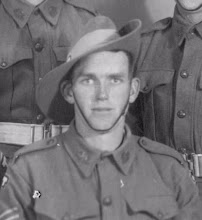This photo was taken at Anzac Day at Sydney in the early to mid 1990's. I was stunned to find that a photo from my personal collection featured the same men as Lt. Fisher's photo. The two men on the outsides are currently unidentified but the others are exactly as posed in the original photo. My Grandfather is second from the right.
The beauty of this photo is in the fact that all 5 men survived the war, however not all of them unscathed. Of the three identified members only Henry Zouch was not reported wounded in action (W.I.A.). Both Charlie Lemaire and Les McCarthy were wounded at Alamein and Les McCarthy was further wounded in New Guinea in 1943 when a Private accidentally discharged his Bren Gun shooting my Grandad twice, once in the right thigh, the other in the right shin. This was a wound that took months to heal. The funny thing is that when the incident was originally reported to Senior Officers my Grandfather, a section Corporal, covered for the Private under his command and reported the wounds as having been received from a strafing Japanese Zero fighter plane. It wasn't until many months later with the potential for an army board of enquiry looming that the official record was amended to reflect that the wounds were received by "accidental discharge of section's Bren Gun". Amazing what information is in official service records.
To view the original post and photo about Tobruk's Bush Artillery click here http://9thdivvy.blogspot.com/2008/07/image-tobruks-bush-artillery.html












